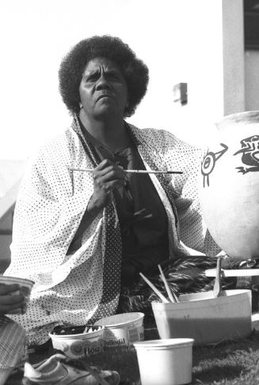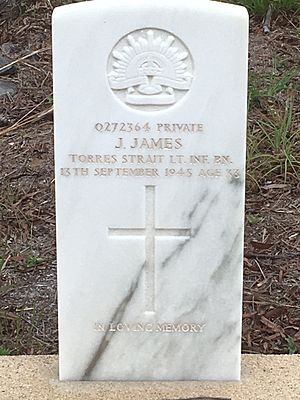Thancoupie facts for kids
Quick facts for kids
Thancoupie
|
|
|---|---|

Thancoupie 1981
|
|
| Born | 1937 |
| Died | 23 April 2011 (aged 73–74) |
| Other names | Thanakupie, Thancoupie, Gloria Fletcher, Thankupi, Dr Gloria Fletcher James AO |
| Known for | Ceramics, Sculpture |
Dr Thancoupie Gloria Fletcher James AO (1937-2011) was an amazing Australian artist. She was also an educator, a language expert, and a respected elder of the Thainakuith people. Her community is in Weipa, in far north Queensland, Australia.
Thancoupie was the last person who could speak the Thainakuith language fluently. This made her a very important person for sharing her community's culture and knowledge. She was also known by other names like Thankupi and Thanakupi.
She played a big part in Australian First Nations art. She helped make ceramics a popular way for First Peoples to express their culture. Thancoupie was also one of the first First Nations artists to become famous on her own.
Besides ceramics, Thancoupie also made art from metal. One of her large bronze sculptures, Eran (2010), is at the entrance of the National Gallery of Australia. Her metal artworks look a lot like her ceramic pieces. They are often round shapes with carvings that show stories from Thainakuith culture. Using metal for cultural art was also new for First Nations artists, just like her work with ceramics.
Thancoupie used her deep knowledge of Thainakuith culture in all her art. Her works are in most major Australian art collections. She is still a very important person in Australian art history.
Contents
Thancoupie's Early Life
Thancoupie was born in 1937 in Weipa. Her parents were Ida and Jimmy James. She was given the name Thanakupi, which means "wattle flower" in her language. Later, she was named Gloria James when she was baptised. She had a twin sister who sadly died young.
In 1945, Thancoupie's father passed away. He was a soldier during World War Two, stationed on Thursday Island.
Thancoupie grew up in a small community called Napranum. She went to the mission school there. Later, she moved to Sydney to study ceramics. When she reconnected with her language, she started using the name Thancoupie. She also used the spelling Thanakupi.
In 1957, mining for bauxite (a type of rock) began in Western Cape York. This meant that non-Indigenous people started to use Thainakuith land. Over time, more and more land was used for mining. This forced many people from her community to move. It also led to a big loss of local cultural knowledge. Thancoupie's art became a way to respond to this. She also joined protests to protect the land rights of her people.
Thancoupie first became known as a painter. Her first art show was in Cairns in 1968. She showed her paintings alongside bark paintings by another artist, Dick Roughsy. Thancoupie had grown up using clay in special ceremonies. This connection to her land and ancestors inspired her to train as a ceramic artist in Sydney. Her first ceramics show was in Volta. She became very involved with Aboriginal communities and activist groups in Sydney. She was also a key member of the arts and crafts community.
In 1976, after finishing her art degree in Sydney, Thancoupie moved to Cairns. There, she set up her own pottery studio. From 1976 to 1983, Thancoupie traveled around the world. She represented Australia at the World Crafts Council. She spoke about how important ceramics were for helping First Nations Australians bring back their culture. In 1986, she became the Australian Cultural Commissioner for a big art show in Brazil.
Thancoupie's Career as an Artist and Educator
Thancoupie was many things: a ceramic artist, a storyteller, an educator, a community leader, and a spokesperson.
She started her career teaching young children in preschool. At the same time, she worked on her art. In 1969, she moved from far north Queensland to study art and ceramics. She went to East Sydney Technical College.
Using ceramics to explore ancestry, beauty, and connection to the land is quite new for First Nations artists in Australia. Unlike First Peoples in other parts of the world, like the Americas or Africa, ceramics was not an ancient art form in Australia. Instead, it's a newer movement. It grew as First Peoples found new ways to express themselves. Thancoupie's art and her teaching career show how the art of the Thainakuith people, and all First Nations peoples, keeps changing. Yet, it always remains an important way to share culture.
Thancoupie, along with Eddy Puruntatamerri, a potter from the Tiwi Islands, helped start the Indigenous ceramic art movement in Australia. Thancoupie's art is in many important collections. These include the National Gallery of Australia and other galleries and museums. Her sculpture, Eran 2010, is at the entrance to the National Gallery of Australia. Thancoupie had more than 20 solo art shows in Australia and other countries.
Community Leader and Storyteller
A big part of Thancoupie's life work was recording the language and stories of the Thaynakwith people. She began sharing her community's stories through clay, tiles, and other ceramic artworks. Thancoupie also started the Weipa Festival. This festival celebrates Indigenous art and performances from all over Australia.
Storytelling is still a very important part of artworks made by First Nations Australian artists. Because of the effects of colonisation in Australia, artists like Thancoupie use strong materials like metal and fired ceramics. These materials help them keep their histories, languages, and beliefs safe through art. Thancoupie showed how ceramic and sculpture art by First Nations Australian artists can always grow and find new meanings.
Awards and Recognition
Thancoupie received many important awards for her work:
- 1998: She received an honorary doctorate from the University of Queensland. This is a special degree given to people who have achieved great things.
- 2003: She was made an Officer of the Order of Australia (AO). This is a high honour given to Australians for their achievements.
- 2006: The Australia Council for the Arts gave her the Visual Arts Emeritus Award. This was for her long career as an Indigenous artist, teacher, and community leader.
- 2008: She received a Queensland Greats Award.
Thancoupie's Personal Life
Thancoupie passed away in 2011 after a long illness. She was 74 years old. She died at Weipa Base Hospital on Cape York.


